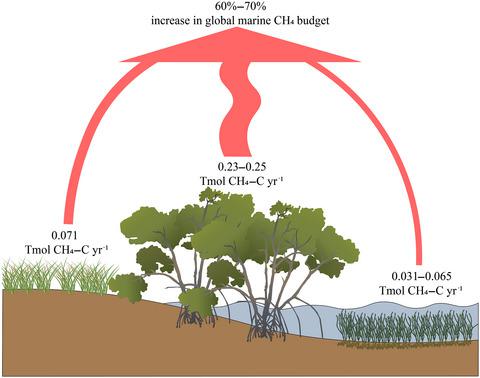当前位置:
X-MOL 学术
›
Glob. Change Biol.
›
论文详情
Our official English website, www.x-mol.net, welcomes your
feedback! (Note: you will need to create a separate account there.)
A synthesis of methane emissions from shallow vegetated coastal ecosystems.
Global Change Biology ( IF 10.8 ) Pub Date : 2020-03-16 , DOI: 10.1111/gcb.15046 Alia N Al-Haj 1 , Robinson W Fulweiler 1, 2
Global Change Biology ( IF 10.8 ) Pub Date : 2020-03-16 , DOI: 10.1111/gcb.15046 Alia N Al-Haj 1 , Robinson W Fulweiler 1, 2
Affiliation

|
Vegetated coastal ecosystems (i.e., mangroves, salt marshes, and seagrasses) play a critical role in global carbon (C) cycling, storing 10x more C than temperate forests. Methane (CH4 ), a potent greenhouse gas, can form in the sediments of these ecosystems. Currently, CH4 emissions are a missing component of vegetated coastal ecosystem C budgets. This review summarizes 97 studies describing CH4 fluxes from mangrove, salt marsh, and seagrass ecosystems and discusses factors controlling CH4 flux in these systems. CH4 fluxes from these ecosystems were highly variable yet they all act as net methane sources (median, range; mangrove: 279.17, -67.33 - 72867.83; salt marsh: 224.44, -92.60 - 94129.68; seagrass: 64.80, 1.25 - 401.50 µmol CH4 m-2 d-1 ). Together CH4 emissions from mangrove, salt marsh, and seagrass ecosystems is about 0.33 to 0.39 Tmol CH4 -C yr-1 - an addition that increases the current global marine CH4 budget by more than 60%. The majority (~45%) of this increase is driven by mangrove CH4 fluxes. While organic matter (OM) content and quality was commonly reported in individual studies as the most important environmental factor driving CH4 flux, when data were combined across studies, it was not a significant predictor of CH4 flux. Salinity was negatively correlated with CH4 emissions from salt marshes, but not seagrasses and mangroves. Thus the available data suggest that other environmental drivers are important for predicting CH4 emissions in vegetated coastal systems. Finally, we examine stressor effects on CH4 emissions from vegetated coastal ecosystems and we hypothesize that future changes in temperature and other anthropogenic activites (e.g., nitrogen loading) will likely increase CH4 emissions from these ecosystems. Overall, this review highlights the current and growing importance of vegetated coastal ecosystems in the global marine CH4 budget.
中文翻译:

来自浅植被沿海生态系统的甲烷排放物的合成。
植被繁茂的沿海生态系统(即红树林,盐沼和海草)在全球碳(C)循环中发挥关键作用,其碳存储量比温带森林多10倍。甲烷(CH4)是一种有力的温室气体,可在这些生态系统的沉积物中形成。目前,CH4排放是沿海植被生态系统C预算中缺少的组成部分。这篇综述总结了97个研究,这些研究描述了来自红树林,盐沼和海草生态系统的CH4通量,并讨论了控制这些系统中CH4通量的因素。这些生态系统的CH4通量变化很大,但它们都是甲烷的净来源(中位数,范围;红树林:279.17,-67.33-72867.83;盐沼:224.44,-92.60-94129.68;海草:64.80,1.25-401.50 µmol CH4 m -2 d-1)。红树林,盐沼和海草生态系统的CH4排放量合计约为0.33至0。39 Tmol CH4 -C yr-1-此添加使当前全球海洋CH4预算增加60%以上。这种增加的大部分(〜45%)是由红树林CH4通量驱动的。尽管个别研究中普遍报告有机物质(OM)的含量和质量是驱动CH4通量的最重要环境因素,但将各个研究的数据合并起来,它并不是CH4通量的重要预测指标。盐度与盐沼中CH4的排放呈负相关,但与海草和红树林的负相关。因此,现有数据表明,其他环境驱动因素对于预测沿海植被系统中的CH4排放也很重要。最后,我们研究了压力源对植被繁茂的沿海生态系统CH4排放的影响,并假设温度和其他人为活动的未来变化(例如,氮负荷)可能会增加这些生态系统中的CH4排放量。总体而言,本评估报告强调了植被无coastal的沿海生态系统在全球海洋CH4预算中的日益重要的地位。
更新日期:2020-04-22
中文翻译:

来自浅植被沿海生态系统的甲烷排放物的合成。
植被繁茂的沿海生态系统(即红树林,盐沼和海草)在全球碳(C)循环中发挥关键作用,其碳存储量比温带森林多10倍。甲烷(CH4)是一种有力的温室气体,可在这些生态系统的沉积物中形成。目前,CH4排放是沿海植被生态系统C预算中缺少的组成部分。这篇综述总结了97个研究,这些研究描述了来自红树林,盐沼和海草生态系统的CH4通量,并讨论了控制这些系统中CH4通量的因素。这些生态系统的CH4通量变化很大,但它们都是甲烷的净来源(中位数,范围;红树林:279.17,-67.33-72867.83;盐沼:224.44,-92.60-94129.68;海草:64.80,1.25-401.50 µmol CH4 m -2 d-1)。红树林,盐沼和海草生态系统的CH4排放量合计约为0.33至0。39 Tmol CH4 -C yr-1-此添加使当前全球海洋CH4预算增加60%以上。这种增加的大部分(〜45%)是由红树林CH4通量驱动的。尽管个别研究中普遍报告有机物质(OM)的含量和质量是驱动CH4通量的最重要环境因素,但将各个研究的数据合并起来,它并不是CH4通量的重要预测指标。盐度与盐沼中CH4的排放呈负相关,但与海草和红树林的负相关。因此,现有数据表明,其他环境驱动因素对于预测沿海植被系统中的CH4排放也很重要。最后,我们研究了压力源对植被繁茂的沿海生态系统CH4排放的影响,并假设温度和其他人为活动的未来变化(例如,氮负荷)可能会增加这些生态系统中的CH4排放量。总体而言,本评估报告强调了植被无coastal的沿海生态系统在全球海洋CH4预算中的日益重要的地位。











































 京公网安备 11010802027423号
京公网安备 11010802027423号